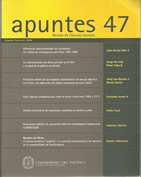Fundamentals of private saving in Peru and the role of economic policy
DOI:
https://doi.org/10.21678/apuntes.47.498Keywords:
Peru, private saving, saving rate, economic policy, fiscal policy, intertemporal consumptionAbstract
The research is about the behavior of private saving in the Peruvian economy and its fundamentals in last half century. On the neoclassical model of growth and some assumptions about the parameters, the authors find that the domestic saving rate that maximizes the intertemporal consumption fluctuates between 28% y 33% of GDP. lt means, more than 10 points of GDP than the 17,4% registered in 1996.
The research also finds theoretical and practical foundations for an active fiscal policy oriented to increase the public saving rate. ln addition, the authors estimate an empirical time series model of the actual behavior of the private savings that fulfills hard statistical tests. Finally, using the statistical model, under some growth and external savings scenarios, the domestic saving rate will be in the optimal range in six or seven years (2003).
Downloads
Downloads
Published
How to Cite
Issue
Section
License
Apuntes publishes all its articles and reviews under a Creative Commons Attribution (CC BY 4.0) license with the objective of promoting academic exchange worldwide. Therefore, articles and book reviews can be distributed, edited, amended, etc., as the author sees fit. The only condition is that the name of the author(s) and Apuntes. Revista de Ciencias Sociales (as the publisher) be cited.



.jpg)
